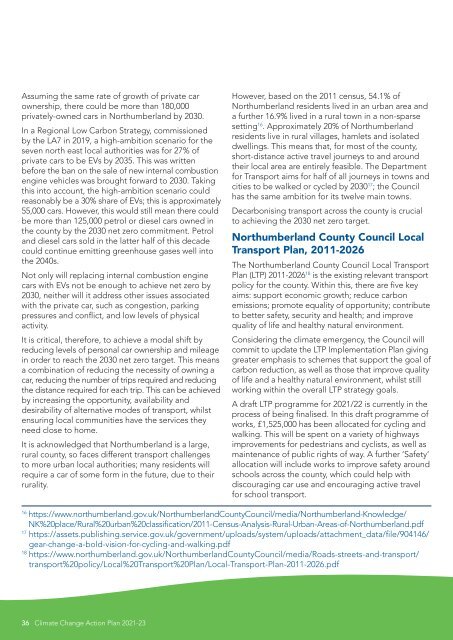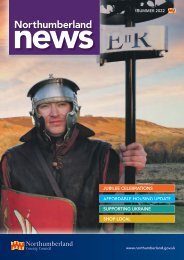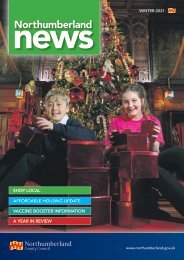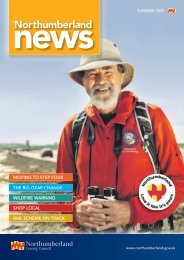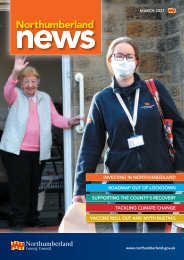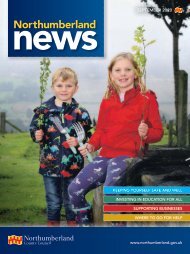Climate change action plan 2021-23
Climate change action plan 2021-23
Climate change action plan 2021-23
You also want an ePaper? Increase the reach of your titles
YUMPU automatically turns print PDFs into web optimized ePapers that Google loves.
Assuming the same rate of growth of private car<br />
ownership, there could be more than 180,000<br />
privately-owned cars in Northumberland by 2030.<br />
In a Regional Low Carbon Strategy, commissioned<br />
by the LA7 in 2019, a high-ambition scenario for the<br />
seven north east local authorities was for 27% of<br />
private cars to be EVs by 2035. This was written<br />
before the ban on the sale of new internal combustion<br />
engine vehicles was brought forward to 2030. Taking<br />
this into account, the high-ambition scenario could<br />
reasonably be a 30% share of EVs; this is approximately<br />
55,000 cars. However, this would still mean there could<br />
be more than 125,000 petrol or diesel cars owned in<br />
the county by the 2030 net zero commitment. Petrol<br />
and diesel cars sold in the latter half of this decade<br />
could continue emitting greenhouse gases well into<br />
the 2040s.<br />
Not only will replacing internal combustion engine<br />
cars with EVs not be enough to achieve net zero by<br />
2030, neither will it address other issues associated<br />
with the private car, such as congestion, parking<br />
pressures and conflict, and low levels of physical<br />
activity.<br />
It is critical, therefore, to achieve a modal shift by<br />
reducing levels of personal car ownership and mileage<br />
in order to reach the 2030 net zero target. This means<br />
a combination of reducing the necessity of owning a<br />
car, reducing the number of trips required and reducing<br />
the distance required for each trip. This can be achieved<br />
by increasing the opportunity, availability and<br />
desirability of alternative modes of transport, whilst<br />
ensuring local communities have the services they<br />
need close to home.<br />
It is acknowledged that Northumberland is a large,<br />
rural county, so faces different transport challenges<br />
to more urban local authorities; many residents will<br />
require a car of some form in the future, due to their<br />
rurality.<br />
However, based on the 2011 census, 54.1% of<br />
Northumberland residents lived in an urban area and<br />
a further 16.9% lived in a rural town in a non-sparse<br />
setting 16 . Approximately 20% of Northumberland<br />
residents live in rural villages, hamlets and isolated<br />
dwellings. This means that, for most of the county,<br />
short-distance active travel journeys to and around<br />
their local area are entirely feasible. The Department<br />
for Transport aims for half of all journeys in towns and<br />
cities to be walked or cycled by 2030 17 ; the Council<br />
has the same ambition for its twelve main towns.<br />
Decarbonising transport across the county is crucial<br />
to achieving the 2030 net zero target.<br />
Northumberland County Council Local<br />
Transport Plan, 2011-2026<br />
The Northumberland County Council Local Transport<br />
Plan (LTP) 2011-2026 18 is the existing relevant transport<br />
policy for the county. Within this, there are five key<br />
aims: support economic growth; reduce carbon<br />
emissions; promote equality of opportunity; contribute<br />
to better safety, security and health; and improve<br />
quality of life and healthy natural environment.<br />
Considering the climate emergency, the Council will<br />
commit to update the LTP Implementation Plan giving<br />
greater emphasis to schemes that support the goal of<br />
carbon reduction, as well as those that improve quality<br />
of life and a healthy natural environment, whilst still<br />
working within the overall LTP strategy goals.<br />
A draft LTP programme for <strong>2021</strong>/22 is currently in the<br />
process of being finalised. In this draft programme of<br />
works, £1,525,000 has been allocated for cycling and<br />
walking. This will be spent on a variety of highways<br />
improvements for pedestrians and cyclists, as well as<br />
maintenance of public rights of way. A further ‘Safety’<br />
allocation will include works to improve safety around<br />
schools across the county, which could help with<br />
discouraging car use and encouraging active travel<br />
for school transport.<br />
16<br />
https://www.northumberland.gov.uk/NorthumberlandCountyCouncil/media/Northumberland-Knowledge/<br />
NK%20place/Rural%20urban%20classification/2011-Census-Analysis-Rural-Urban-Areas-of-Northumberland.pdf<br />
17<br />
https://assets.publishing.service.gov.uk/government/uploads/system/uploads/attachment_data/file/904146/<br />
gear-<strong>change</strong>-a-bold-vision-for-cycling-and-walking.pdf<br />
18<br />
https://www.northumberland.gov.uk/NorthumberlandCountyCouncil/media/Roads-streets-and-transport/<br />
transport%20policy/Local%20Transport%20Plan/Local-Transport-Plan-2011-2026.pdf<br />
36<br />
<strong>Climate</strong> Change Action Plan <strong>2021</strong>-<strong>23</strong>


